Introduction
The purpose of this paper is to examine the relationships between the variables represented by the physical characteristics of motion with acceleration. Physics postulates that as the force applied to a body increases, so does the acceleration since they are related by direct proportionality. In contrast, the relationship between body mass and acceleration is inversely proportional, from which it follows that an increase in mass leads to a decrease in acceleration: a heavier body will naturally move with less acceleration. Testing these postulates is part of the present laboratory work, in which a cart moved along a horizontal surface under the action of an applied force.
Analysis
For the study, an experiment was carried out in which the motion of the cart was given by force applied to it, realized through a weight suspended from a pulley. In one case, the mass of the weights was changed, resulting in a change in the speed of the cart. The table below shows the data obtained empirically during the experiments.
Based on the data obtained, it was possible to plot the velocity vs. time for all seven measurements. For each graph, linear regression equations were modeled, the slope of which determined the acceleration for each of the carts. In fact, acceleration is defined as the derivative of the velocity function over time, which is the slope of the regression function, given the high accuracy of each simulation (The OC Tutor, 2021). Thus, the seven accelerations were derived and are shown as slopes in the figure below.

Based on the acceleration and mass of each cart, it is possible to calculate the values of the applied forces in N. The calculation is based on Newton’s second law, which relates acceleration, mass, and the value of force by the formula F = ma for the body. It is important to note that for correct calculations, all mass values have been converted to kilograms to respect the dimensionality of the units.
At first glance, one can see that increasing the mass of the weight led to an increase in the applied force, which was mediated by an increase in the acceleration of the cart. The figure below shows a graph of acceleration vs. force for two different masses of weights. It can be seen that both dependencies were linear, which fully confirms the theoretical relationship between acceleration and force from Newton’s second law. In other words, as the value of the applied force increases, the acceleration of the cart will increase linearly.

Uncertainties played an essential role in the laboratory work. For direct measurements of time, the uncertainty was ±0.0005 seconds as half the minimum threshold, and for speed, ±0.0005 m/s. The uncertainties of acceleration and force must be calculated through percentage uncertainties because multiplication and division occur in this case. The uncertainty affects the accuracy of the final results because it corresponds to the errors associated with the measurements: the higher the uncertainty, the less accurate the final results are.
Conclusion
There is a direct linear relationship between acceleration and applied force, which has an ascending nature. This means that increasing the mass of the weights attached to the pulley does affect the increase in acceleration. In turn, the data obtained are in accordance with theoretical expectations, according to Newton’s second law of motion.
Reference
The OC Tutor. (2021). Velocity time graphs, acceleration & position time graphs – physics. YouTube.